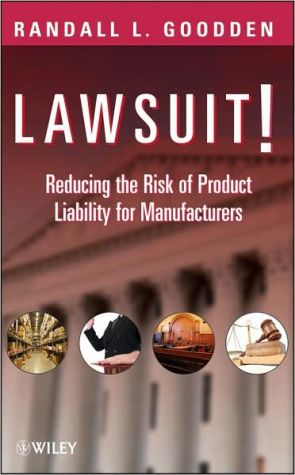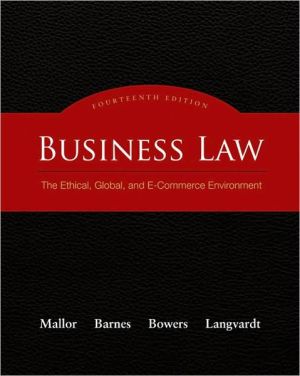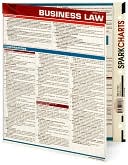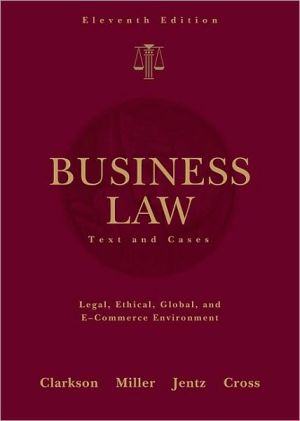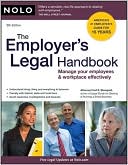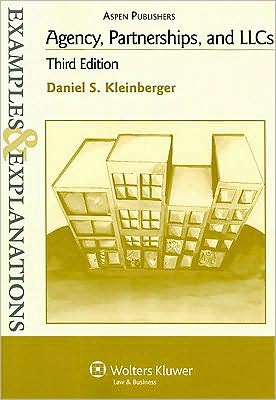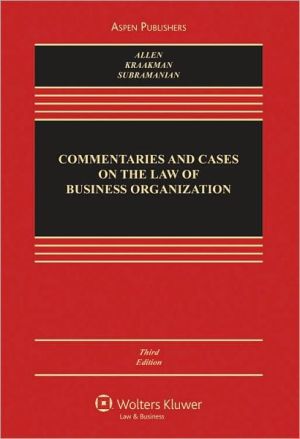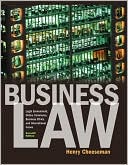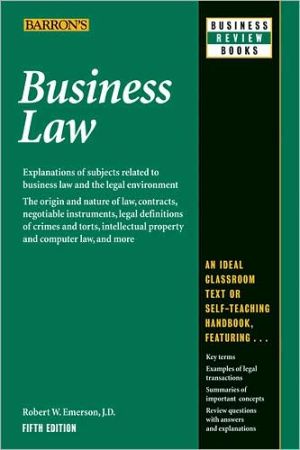Lawsuit!: Reducing the Risk of Product Liability for Manufacturers
Addressing product liability concerns and laws both in the U.S. and internationally, this book helps manufacturers and engineers develop and implement proactive processes that can reduce liability concerns and potential lawsuits. It discusses preventive measures in the engineering, development, and manufacturing of products and explains the procedures and processes manufacturers must have in place to reduce the likelihood of liability as well as to provide the best defense in case of a...
Search in google:
Easy-to-follow, easy-to-implement procedures for avoiding costly product liabilityProtect your company against the possibility of a costly product liability lawsuit. Lawsuit! takes you through all the procedures and processes that manufacturers need to have in place to limit their exposure to product liability claims. These procedures and processes also ensure that you'll have the best defense ready in the event that your organization is faced with a lawsuit.Author Randall Goodden is one of the world's leading experts on product liability prevention. His advice is based on more than twenty-five years of hands-on experience as a manufacturing executive. Everything you need to know to reduce your firm's exposure to product liability claims is clearly set forth in non-technical language, including:Step-by-step instructions, along with accompanying examples, for implementing risk-reduction proceduresCompliance guidelines for meeting the requirements of government product safety organizationsExamples of lawsuits that underscore the need for a rigorous risk-reduction programThorough explanations of the law and legal processesLawsuit! covers both U.S. and international law, making it appropriate for manufacturing companies around the world. In addition to avoiding product liability lawsuits, this book helps manufacturers maximize profits by being less wasteful and, at the same time, more effective in launching new products.Following the book's easy-to-follow and easy-to-implement procedures is your best defense against product liability suits that could potentially ruin your company's reputation and bottom line.
Preface xiiiAcknowledgements xv1 An Introduction to Products Liability 11.1 Courts and Jury Perceptions 41.2 Judicial Hellholes 51.3 Legal Reform 71.4 Impact on Manufacturers 81.5 Public Perception of Corporations 101.6 Product Liability from the Insurance Perspective 151.7 Insurance Companies Supporting PLP Programs 181.8 Recommendations that Can Be Used on Products Liability Accounts Related to Design, Advertising, Instructions, and Product Recall 201.9 Tougher Requirements from the CPSC 221.10 #1 Verdict of 1999: $4.9 Billion Against GM for Gas-Tank Explosion-Live Defense Demonstration Backfires and Turns the Tide 262 Product Liability Around the World 352.1 United States 382.2 Australia 502.3 Canada 592.4 China 672.5 Europe: Part 1 712.6 Europe: Part 2 762.7 Japan 833 Product Liability Law 933.1 Restatment Third of Torts 943.2 Commonly Used Terms and Definitions 984 New Product Introduction: More Effective Design Reviews 1154.1 The Different Stages or Types of Design Reviews 1224.2 Creating the Design Review Team 1234.3 Making Design Reviews the Policy 1254.4 Developing the Design Review Procedure 1274.5 Minutes of the Design Review 1314.6 Policies and Procedures-Assets and Liabilities 1314.7 Engineering Change Control 1324.8 Traceability and Recall Preparedness 1334.9 Measuring the Effectiveness of the Design Review Team 1344.10 In Conclusion 1345 New Product Introduction: Product Safety Reviews Hazards Analysis, and Risk Assessment 1355.1 Creating the Product Safety Team 1365.2 Elements of the Hazards Analysis 1375.3 Design Review-a Viewpoint of theConsumer Product Safety Commission (CPSC) 1385.4 Failure Mode and Effects Analysis (FMEA) 1395.5 Cause-and-Effect Diagram 1425.6 MIL-STD 882 1435.7 Hazards Analysis Software 1486 Product Testing 1496.1 The Initial Design Process 1506.2 Conducting Product Tests 1506.3 Building a Testing Lab 1516.4 Complying with Domestic or International Standards 1546.5 Testing Products and Reacting to Test Results 1547 Warnings and Instructions 1577.1 The Legal Duty to Warn 1587.2 Presumption 1597.3 No Need to Warn Sophisticated Users 1607.4 The 2007 ANSI Z535.4 Standard for Product Safety Signs and Labels 1617.5 The New Standard: ANSI Z535.6 1738 Product Warranties 1798.1 Examples of Warranty, Warranty Disclaimer, and Exclusive Remedy 1808.2 Limitation of Liability 1808.3 A Businessperson's Guide to Federal Warranty Law (ftc.gov) 1818.4 Offering Service Contracts 1998.5 Statement of Terms and Conditions 2008.6 Disclaimer or Limitation of Implied Warranties 2009 Product Marketing 2019.1 Deceptive Advertising v. Defects in Marketing 20410 Contracts, Purchase Orders, and Agreements 20710.1 Lack of Supplier Control 20810.2 Guilty by Association 20910.3 Purchase Orders 21010.4 Recall Considerations 21210.5 Distribution of the Purchase Order Terms and Conditions 21210.6 Customer Contracts 21310.7 The China Syndrome 21510.8 Restructuring Import Contracts When Importing Goods from China 21611 Records Retention and Dangerous Documents 22711.1 Records Retention Programs 22811.2 Hard Copy Storage 22911.3 Records can be Key for Defense 23111.4 Document Management and Recognizing "Dangerous Documents" 23311.5 Electronic Documents and Discovery 23911.6 The New e-Discovery Burden 24011.7 Employee Education 24212 The Administrative Team 24312.1 Selecting a Primary Driver 24412.2 Creating the Administrative Team 24512.3 Gaining the Necessary Knowledge 24612.4 Announcements to the Rest of the Organization 24612.5 Selecting an Outside Attorney 24712.6 Auditing the Operation 24712.7 Developing an Implementation Plan 25212.8 Administrative Team Meetings 25312.9 Executive Action-a View from the CPSC 25413 Post Sale Duties to Warn and Recalls 25713.1 Estimating the Economic Impact of Product Recalls 26013.2 "Made in China" Recalls of 2007 26013.3 Implementing a Recall 26213.4 Developing a Procedure 26313.5 The Tylenol Recall 26613.6 Government Agencies Involved with Certain Product Recalls 26713.7 EU Recall Planning Guide 28813.8 Some Final Thoughts on Recall Prevention 29714 The Quality System: Incorporating Safeguards into the Procedures 29914.1 The Legal Focus on Quality 30114.2 How Quality Can Become a Liability 30114.3 The PLP Problem with Quality Programs 30214.4 Evaluating the Quality Program 30414.5 Incorporating PSLP into the Quality Program 30514.6 Product Safety and Quality Guidelines by the CPSC 30714.7 Product Safety Policy 30714.8 Organization 30714.9 Training 30714.10 Technical Guidance 30815 Claims and Investigating Incidents 31515.1 How The Company Learns About Problems 31615.2 In-House Awareness Training 31715.3 Preparing for an Investigation 31915.4 Gathering the Facts 32115.5 Inspecting the Evidence 32215.6 Writing a Report 32416 Entering into Litigation 32716.1 Selecting the Defense Attorney 32816.2 Product Liability (Civil Case) Trial Procedure 32916.3 Appellate Procedure 33016.4 Discovery: Interrogatories 33116.5 Discovery: Requests for Documents 33216.6 Discovery: Depositions 33316.7 Preparing for Trial: Testifying Expert v. Non-Testifying Expert 33416.8 Pretrial Stage: Mandatory Settlement Conference 33516.9 Pretrial Defense Strategies: Motion in Limine 33516.10 Discovery: Defense Strategies 33516.11 Assessing Damages and Punitive Awards 34316.12 Product Liability Case Studies from Appellate Courts 344Index 353
\ From the Publisher'The book is essential reading for anyone supplying goods to the North American market, especially in view of the high levels of general and punitive damages that have been awarded in US product safety cases.? ( Health & Safety at Work , October 2009)\ \ \
